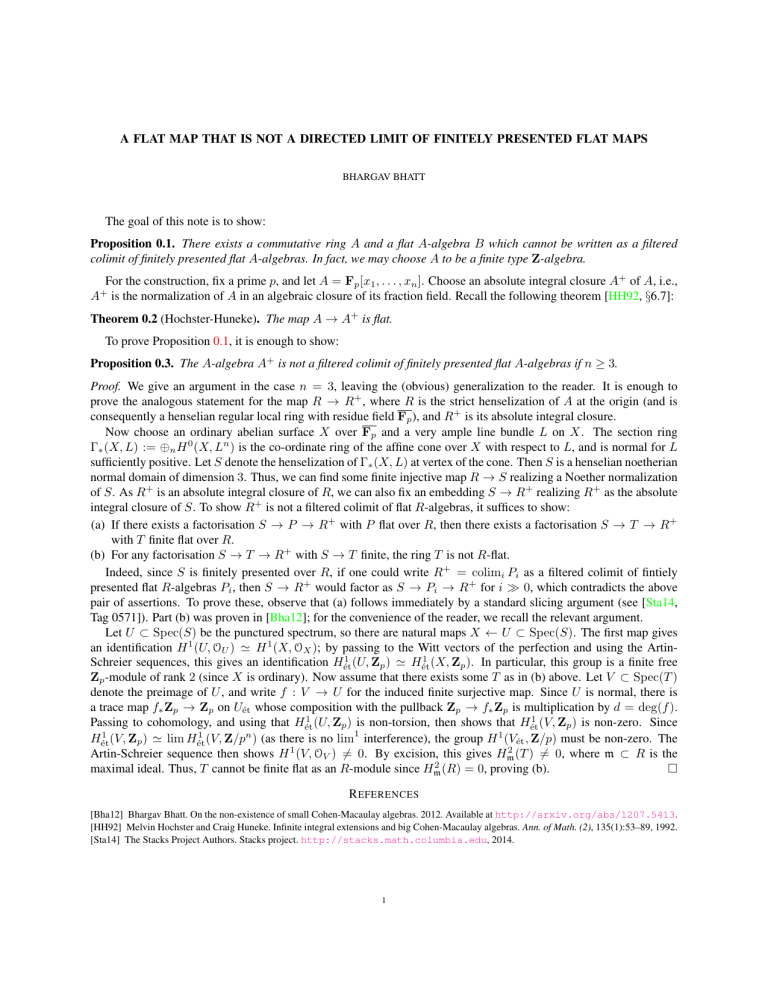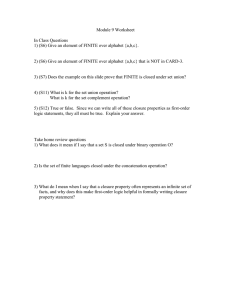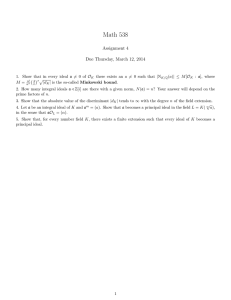A FLAT MAP THAT IS NOT A DIRECTED LIMIT OF FINITELY
advertisement

A FLAT MAP THAT IS NOT A DIRECTED LIMIT OF FINITELY PRESENTED FLAT MAPS BHARGAV BHATT The goal of this note is to show: Proposition 0.1. There exists a commutative ring A and a flat A-algebra B which cannot be written as a filtered colimit of finitely presented flat A-algebras. In fact, we may choose A to be a finite type Z-algebra. For the construction, fix a prime p, and let A = Fp [x1 , . . . , xn ]. Choose an absolute integral closure A+ of A, i.e., A is the normalization of A in an algebraic closure of its fraction field. Recall the following theorem [HH92, §6.7]: + Theorem 0.2 (Hochster-Huneke). The map A → A+ is flat. To prove Proposition 0.1, it is enough to show: Proposition 0.3. The A-algebra A+ is not a filtered colimit of finitely presented flat A-algebras if n ≥ 3. Proof. We give an argument in the case n = 3, leaving the (obvious) generalization to the reader. It is enough to prove the analogous statement for the map R → R+ , where R is the strict henselization of A at the origin (and is consequently a henselian regular local ring with residue field Fp ), and R+ is its absolute integral closure. Now choose an ordinary abelian surface X over Fp and a very ample line bundle L on X. The section ring Γ∗ (X, L) := ⊕n H 0 (X, Ln ) is the co-ordinate ring of the affine cone over X with respect to L, and is normal for L sufficiently positive. Let S denote the henselization of Γ∗ (X, L) at vertex of the cone. Then S is a henselian noetherian normal domain of dimension 3. Thus, we can find some finite injective map R → S realizing a Noether normalization of S. As R+ is an absolute integral closure of R, we can also fix an embedding S → R+ realizing R+ as the absolute integral closure of S. To show R+ is not a filtered colimit of flat R-algebras, it suffices to show: (a) If there exists a factorisation S → P → R+ with P flat over R, then there exists a factorisation S → T → R+ with T finite flat over R. (b) For any factorisation S → T → R+ with S → T finite, the ring T is not R-flat. Indeed, since S is finitely presented over R, if one could write R+ = colimi Pi as a filtered colimit of fintiely presented flat R-algebras Pi , then S → R+ would factor as S → Pi → R+ for i 0, which contradicts the above pair of assertions. To prove these, observe that (a) follows immediately by a standard slicing argument (see [Sta14, Tag 0571]). Part (b) was proven in [Bha12]; for the convenience of the reader, we recall the relevant argument. Let U ⊂ Spec(S) be the punctured spectrum, so there are natural maps X ← U ⊂ Spec(S). The first map gives an identification H 1 (U, OU ) ' H 1 (X, OX ); by passing to the Witt vectors of the perfection and using the Artin1 1 Schreier sequences, this gives an identification Hét (U, Zp ) ' Hét (X, Zp ). In particular, this group is a finite free Zp -module of rank 2 (since X is ordinary). Now assume that there exists some T as in (b) above. Let V ⊂ Spec(T ) denote the preimage of U , and write f : V → U for the induced finite surjective map. Since U is normal, there is a trace map f∗ Zp → Zp on Uét whose composition with the pullback Zp → f∗ Zp is multiplication by d = deg(f ). 1 1 Passing to cohomology, and using that Hét (U, Zp ) is non-torsion, then shows that Hét (V, Zp ) is non-zero. Since 1 1 1 Hét (V, Zp ) ' lim Hét (V, Z/pn ) (as there is no lim interference), the group H 1 (Vét , Z/p) must be non-zero. The 2 Artin-Schreier sequence then shows H 1 (V, OV ) 6= 0. By excision, this gives Hm (T ) 6= 0, where m ⊂ R is the 2 maximal ideal. Thus, T cannot be finite flat as an R-module since Hm (R) = 0, proving (b). R EFERENCES [Bha12] Bhargav Bhatt. On the non-existence of small Cohen-Macaulay algebras. 2012. Available at http://arxiv.org/abs/1207.5413. [HH92] Melvin Hochster and Craig Huneke. Infinite integral extensions and big Cohen-Macaulay algebras. Ann. of Math. (2), 135(1):53–89, 1992. [Sta14] The Stacks Project Authors. Stacks project. http://stacks.math.columbia.edu, 2014. 1


